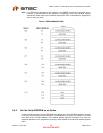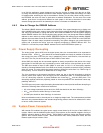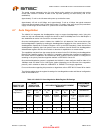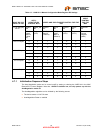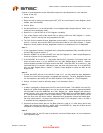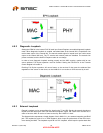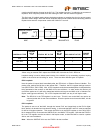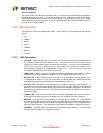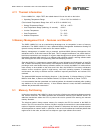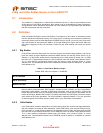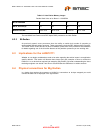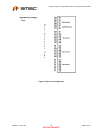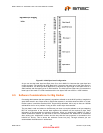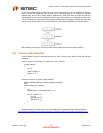
SMSC LAN91C111 32/16/8-Bit Three-In-One Fast Ethernet Controller
Revision 1.0 (08-14-08) 34 SMSC AN 9.6
APPLICATION NOTE
External Loopback:
The packet is sent out of the MAC, through the PHY, out of the RJ45 connector and then looped back
through external wiring or relay. In this mode the MAC and PHY must always be set for full duplex,
since the transmitted packet will start to be received before it is completely out on the wire. For this
test the SWFDUP bit in the TCR register is set, as well as the DPLX bit in the RPCR register (or DPLX
bit in the PHY for external PHYs).
4.10 LED Operation
The LAN91C111 offers two programmable LEDs. These LEDs can be programmed to the following
outputs:
1. Link
2. 10Mbps
3. Duplex
4. Activity
5. 100Mbps
6. Receive
7. Transmit
4.10.1 LED Description
1. LINK LED -- When the chip powers up or resets, the MII_DIS bit in the MI Control Register is set
to 1 and the internal PHY enters isolation mode. The transmit Link pulse is not sent until the
internal PHY leaves isolation mode by clearing the MII_DIS bit. The chip will try to establish an
active link to and from a remote device by using either the standard link integrity or the
AutoNegotiation algorithm (if AutoNegotiation mode is on). Once an active link has been
successfully established, the link LED will be turned on.
2. 10Mbps LED – After an active link has been successfully established, the LAN91C111 and the
remote device are both configured to 10Mbps mode, the 10Mbps LED will be turned on.
3. DUPLEX LED – Duplex LED is on when 1) the DPLX bit in Receive/PHY Control Register is set
if AutoNegotiation mode is off, or 2) the chip sensed and placed itself into full duplex mode after
AutoNegotiation process is completed when AutoNegotiation mode is on.
4. ACTIVITY LED – The LED blinks when packets are transmitted or received by the LAN91C111. If
the Ethernet controller receives the packets that don’t match to it’s MAC address (Except broadcast
packets) or can not pass address filtering, the controller will disregard the packets. But the LED
still blinks during the receive process. This LED does not blink when the LAN91C111 transmits or
receives link pulses.
5. 100Mbps LED -- After an active link has been successfully established, the LAN91C111 and the
remote device are both configured to 100Mbps mode, the 100Mbps LED will be turned on.
6. RECEIVE -- The LED blinks when packets are received by the LAN91C111. If the Ethernet
controller receives the packets that don’t match to it’s MAC address (Except broadcast packets) or
can not pass address filtering, the controller will disregard the packets. But the LED still blinks
during the receive process. This LED does not blink when the LAN91C111 receives link pulses.
7. TRANSMIT -- The LED blinks when packets are transmitted by the LAN91C111. This LED does
not blink when the LAN91C111 transmits link pulses.



